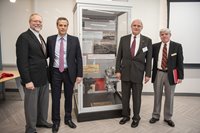#273 Westinghouse Automatic Air Brake
1869, 1872
Westinghouse Automatic Air Brake
George Westinghouse’s revolutionary development of the automatic air brake had a built-in safeguard that allowed the entire train to come to a halt if air pressure escaped or if train cars would become separated. His triple-valve system, or control-valve proved to be a significant improvement over the direct-air brake system, which used an air compressor to feed air through a brake pipe into air tanks for each car – engaging the braking mechanism.
His creation of the triple-valve system (which incorporated individual compressed air reservoirs on each rail car) and its refinements led to dramatic improvements in safety for brakemen and expanded the popularity of rail travel in North America while helping to expand economies. Today, the triple-valve mechanism has almost universally been adopted for use in the United States and around the world.
Landmark Location
Wabtec
30 Isabella Street
Pittsburgh, PA 15212
Visiting Info
By Appointment Only
(412) 825-1000
www.wabtec.com/contact
Ceremony Date:
Oct. 15, 2019. Plaque presented by ASME President-nominee Bryan Erler


